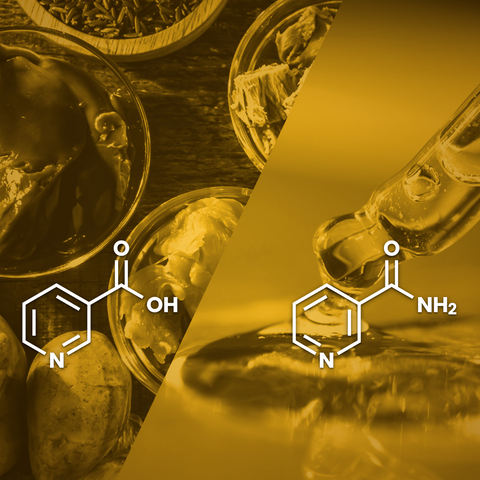
Nicotinic acid and nicotinamide are different forms of vitamin B3 found in food. These compounds have identical vitamin activity; however, their pharmacological profiles differ. Indeed, nicotinamide has an amide group, notably absent in nicotinic acid, which confers different therapeutic and side effects. For instance, nicotinamide lacks the lipid-modifying effects of reducing cholesterol of nicotinic acid. It also lacks some adverse effects, such as causing flushing and hypotension [1,2]. Depending on the country, nicotinic acid and nicotinamide are referred to as niacin and niacinamide, respectively, compounding confusion.
Nicotinic acid or niacin
Nicotinic acid is involved in the metabolism of macronutrients, including carbohydrates, proteins, and lipids, via the nicotinamide adenine dinucleotide (NAD) and nicotinamide adenine dinucleotide phosphate (NADP) coenzymes [3,4]. It is found in food rich in proteins (including legumes, cereals, meat, and milk) and yeast [5].
Mechanisms of action
Nicotinic acid positively modulates apolipoprotein (apo) B-containing lipoproteins, including very-low-density lipoprotein (VLDL), low-density lipoprotein (LDL), and lipoprotein(a). It also increases apo A-I-containing lipoproteins, such as high-density lipoprotein (HDL). Several studies indicate that nicotinic acid non-competitively inhibits hepatocyte diacylglycerol acyltransferase-2, an essential enzyme for triglyceride synthesis, which accelerates intracellular hepatic apo B degradation and decreases secretion of VLDL and LDL particles [6]. In vitro and in vivo, nicotinic acid retards the hepatic catabolism of apo A-I versus apo A-II, resulting in an increased HDL half-life and HDL concentrations. Other studies report that nicotinic acid increases vascular endothelial cell redox state and, as a result, inhibits oxidative stress and vascular inflammatory genes [7].
Indications
A dietary deficiency of nicotinic acid leads to pellagra, a serious condition characterized by dermatitis, diarrhea, and dementia. However, nicotinamide is recommended for treating nicotinic acid deficiency and pellagra due to its better tolerance than nicotinic acid [5]. Nicotinic acid has been used since 1955 for its lipid-modifying properties over triglycerides, LDL, VLDL, and HDL [8]. Thus, it is indicated as a monotherapy or combined with statins to treat hyperlipidemia [9,10] and dyslipidemia [11]. It is also used to reduce the risk of nonfatal myocardial infarction [12,13] and used to treat atherosclerosis [12].
Safety and side effects
The most common adverse effects of nicotinic acid are flushing, pruritus, gastrointestinal intolerance, hyperglycemia, hyperuricemia, and hypotension [8]. It may cause liver injury in rare cases [14]. Patients with diabetes, uncontrolled hypothyroidism, renal failure, and elderly patients taking concomitantly simvastatin or lovastatin are at increased risk of myopathy [15] and rhabdomyolysis [16].
Nicotinamide or niacinamide
Nicotinamide, like nicotinic acid, is a form of vitamin B3, therapeutically effective against many conditions, ranging from skin disorders to depression [17]. It is naturally found in trace amounts in meat, fish, mushrooms, nuts, and, to a lesser extent, in some vegetables [18].
Mechanisms of action
A large portion of nicotinamide is converted into NAD. This increase in NAD levels modulates mitochondrial production of ATP and superoxide while increasing cell viability against neuronal damage and metabolic diseases via activated sirtuin proteins, a family of NAD-dependent deacetylases [17]. Nicotinamide demonstrates neuroprotective effects. For instance, it supports DNA stability and membrane integrity via protein kinase B activation and the inhibition of several caspases, preventing cellular injury and apoptosis [19,20]. It also inhibits the activity of PARP, an enzyme involved in DNA repair and cell death, that causes the depletion of NAD and ATP in excess [3], contributing to neuroprotection [17]. In cells and animal models, nicotinamide possesses anti-inflammatory properties by down-regulating the expression of pro-inflammatory cytokines [21]. It also reduces neutrophil chemotaxis and mononuclear cell infiltration, suppressing the formation of pro-inflammatory environments [22]. Nicotinamide also presents anti-diabetic effects [23]; however, although the mechanisms previously described involving PARP and sirtuins may be implicated, more research is needed.
Indications
Nicotinamide is indicated for the treatment of pellagra [24] (as previously mentioned), bullous pemphigoid, and peripheral neuritis [25]. Due to its neuroprotective properties, it has been tested in clinical trials in patients with Alzheimer’s disease, though the results have been contradictory [26,27]. It showed positive effects for the treatment of osteoarthritis with improvements in joint flexibility, decreased inflammation, and reduced arthritis severity [28]. Several clinical trials demonstrated positive effects in type-1 diabetes [29]. Nicotinamide also showed beneficial effects in the treatment of depression [30]. Finally, oral nicotinamide significantly reduces skin cancers (cutaneous squamous cell carcinoma and basal cell carcinomas) in clinical trials [31]. Additionally, it is used in the treatment of acne and other skin disorders [18].
Safety and side effects
In a phase II clinical trial investigating nicotinamide in patients with Alzheimer's disease, nicotinamide was well-tolerated [32]. Large doses of oral nicotinamide can lead to hepatotoxicity [33]. In topical application, nicotinamide side effects are rare and include mild burning, erythema, and pruritus [34].
Conclusion
Nicotinic acid and nicotinamide are both forms of the B vitamin B3, with similar chemical structures. However, nicotinamide differs from nicotinic acid by the presence of an amide group in the meta position of the pyridine ring. This structural difference gives distinct properties to these compounds, even though they share the same vitamin activity. Nicotinic acid and nicotinamide are also called niacin and niacinamide, respectively, which often contributes to confusion between them. While nicotinic acid exhibits hypolipidemic properties, nicotinamide possesses neuroprotective, anti-inflammatory, and anti-diabetic effects.
References
[1] Kirkland, J.B. (2012) Niacin requirements for genomic stability. Mutation Research/Fundamental and Molecular Mechanisms of Mutagenesis, 733, 14–20. https://doi.org/10.1016/j.mrfmmm.2011.11.008
[2] Jaconello, P. (1992) Niacin versus niacinamide. CMAJ: Canadian Medical Association Journal = Journal de l’Association Medicale Canadienne, 147, 990.
[3] Williams, A.C., Hill, L.J. and Ramsden, D.B. (2012) Nicotinamide, NAD(P)(H), and Methyl-Group Homeostasis Evolved and Became a Determinant of Ageing Diseases: Hypotheses and Lessons from Pellagra. Current Gerontology and Geriatrics Research, 2012, 302875. https://doi.org/10.1155/2012/302875





Comments (0)
There are no comments for this article. Be the first one to leave a message!